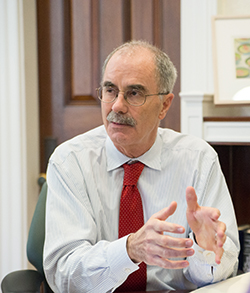In his first major address to the faculty, President Phil Hanlon ’77 outlined his vision for Dartmouth’s next decade and previewed his priorities, including increasing the size of the faculty, offering more opportunity for experiential education, expanding Thayer School of Engineering, adding offerings at the Tuck School of Business, and considering creation of a free-standing graduate school.
President Phil Hanlon ’77 talks with reporters prior to his speech to the faculty. (Photo by Eli Burakian ’00)
“I am enthused about the future and excited about what we can get in place in the next couple of years working together,” President Hanlon told more than 200 faculty members at the annual General Faculty meeting, which includes faculty from Dartmouth’s three professional schools as well as the Faculty of Arts & Sciences. “You are an outstanding faculty, and I feel very fortunate to have you as my new colleagues.”
Hanlon discussed a number of new efforts that would elevate the College’s educational and scholarly mission, keep Dartmouth at the forefront of teaching and learning, and, he said, “take this already great academic enterprise to new levels.”
In addition to detailing his priorities, the president said Dartmouth will work to keep down the cost of attending the Ivy League school.
“You should expect that Dartmouth will keep its tuition rates flat in real terms. In other words, our cost of attendance will track in the future much more closely to some justifiable rate of inflation,” he said.
The new initiatives Hanlon envisions for Dartmouth include:
- Expanding Thayer to build on the engineering school’s innovative, experiential learning and explore opportunities to integrate engineering into the liberal arts.
- New programs at Tuck, including a 4+1 degree program that would provide a master’s in management following a fifth year at Dartmouth; expansion of the Tuck Business Bridge Program; and expansion of Tuck faculty to support programmatic growth.
- Creation of a free-standing graduate school to oversee PhD and master’s programs as well as interdisciplinary graduate programs.
- Partnerships with leading learning technology consortia, including MOOCS (massive open online courses) to enhance the learning experience of Dartmouth students by increasing engagement and using data to better understand how students are progressing through the learning curve.
- Expanding the faculty by hiring clusters in various disciplines and schools around a common theme for interdisciplinary work on important issues. For example, a financial markets cluster could include faculty in business, economics, government, and history.
- Enhancing the Dartmouth Center for the Advancement of Learning (DCAL) and strengthening its partnership with academic computing to develop support models for faculty experimentation and innovation with learning technologies.
- Funding new and innovative faculty research ideas through a program administered by the Provost’s Office.
The initiatives are designed to make Dartmouth a “magnet for human talent,” at the forefront of intellectual innovation and risk-taking, and a “place of big ideas and bold efforts,” said Hanlon.
These new priorities seek to strengthen the College overall and enhance the undergraduate experience. “Dartmouth is best-in-class at the education mission. This is a strategic advantage that we must not give up,” he said.
Hanlon called for an expansion of Dartmouth’s existing work in experiential learning—learning by doing—in areas such as the Policy Research Shop at the Nelson A. Rockefeller Center for Public Policy and the Social Sciences, project-based engineering and design courses at Thayer, and the “40 Towns” online magazine of literary journalism started by students in a creative nonfiction writing class.
“You learn that by doing—by trying, by failing, by being coached, by trying again,” Hanlon said.
The president also reiterated his commitment to programs and efforts that have been announced since he took office in June, including:
- Creation of a Society of Fellows, which will bring 20 to 24 young post-doctoral scholars to “fill the middle” on campus, increasing the quantity of academics who fall between undergraduates and tenured faculty as a way to bring new energy and ideas to campus.
- Opening an Innovation and Entrepreneurial Center to provide an environment in which students have access to resources that will help them put ideas into action and start business ventures and social entrepreneurial initiatives. The center is slated to open in March 2014.
- Fostering innovative medical interventions and outcomes research with the assistance of an $18 million grant from the National Institutes of Health.
A combination of new philanthropy and redeployment of existing resources will fund these new initiatives, Hanlon said. “But philanthropy will not be enough. We will need to self-invest as well, by prioritizing all the activities we do and freeing up resources from those that are least effective or of lowest priority for investment in excellence and new initiatives. This is what any truly successful organization does.”
The November 4 speech in Alumni Hall didn’t touch on the area of student life, which Hanlon will discuss in an address to the Faculty of Arts & Sciences at its November 18 meeting.
> President Hanlon’s full remarks
